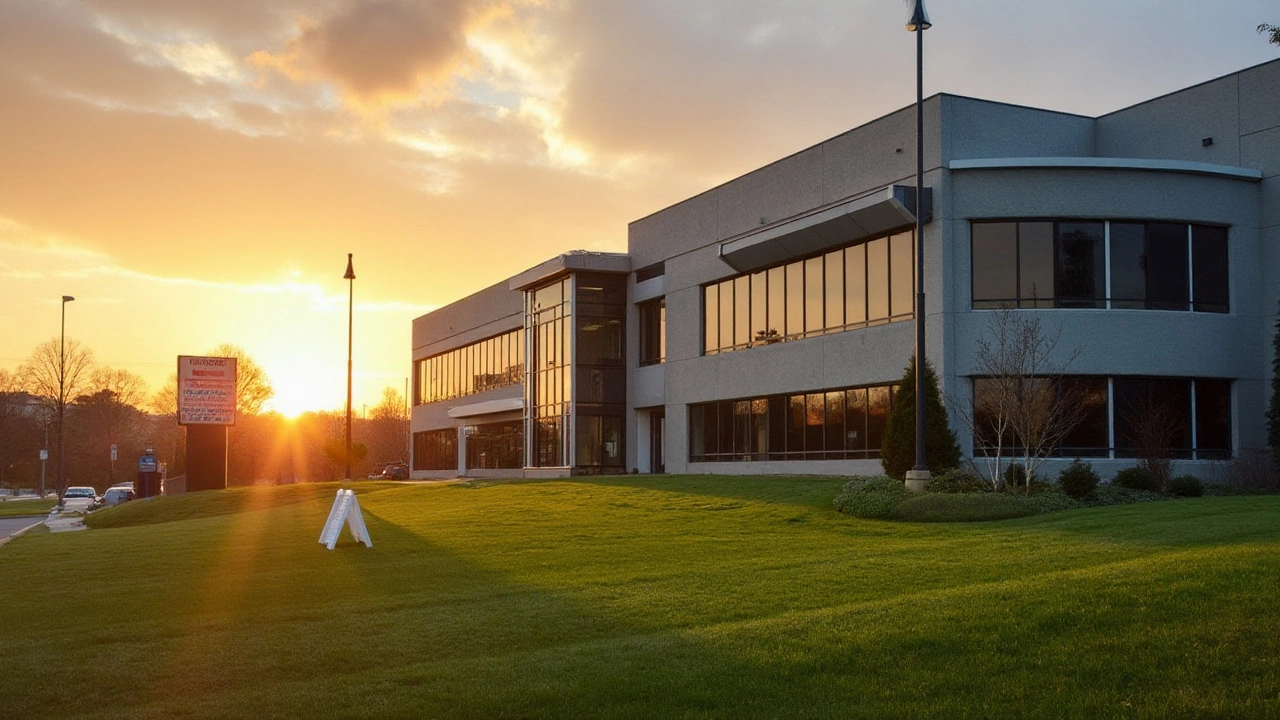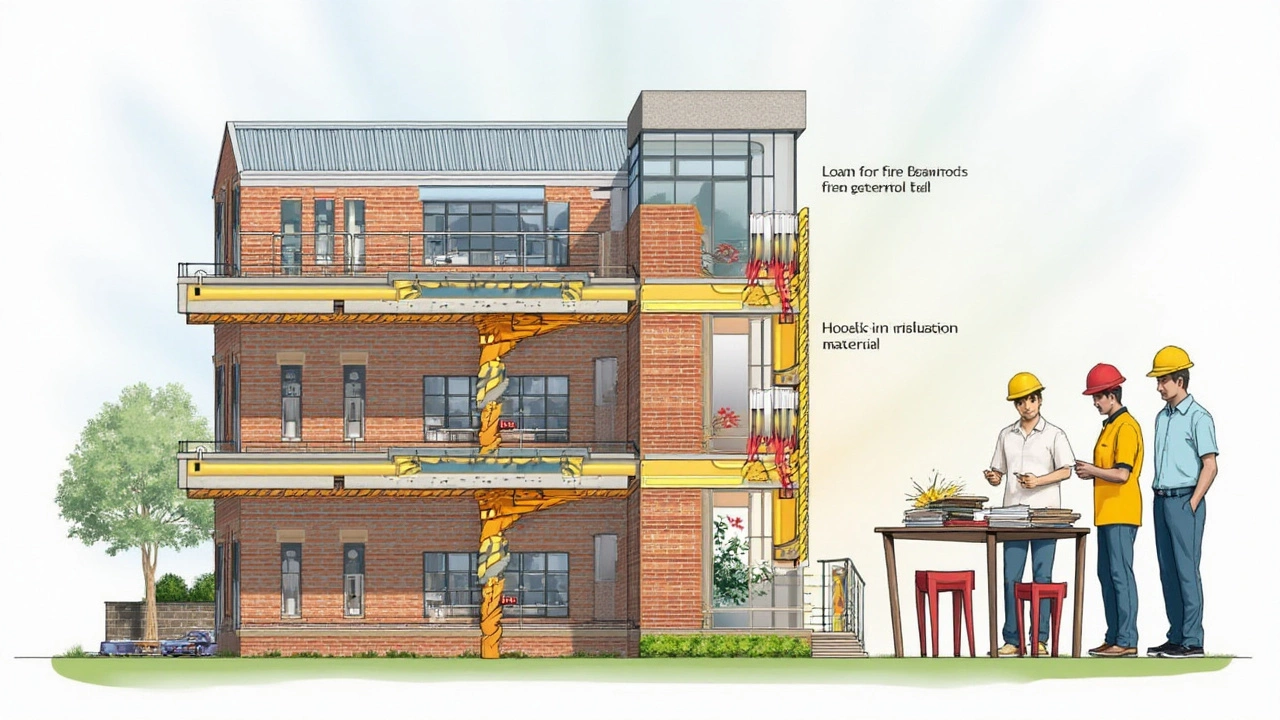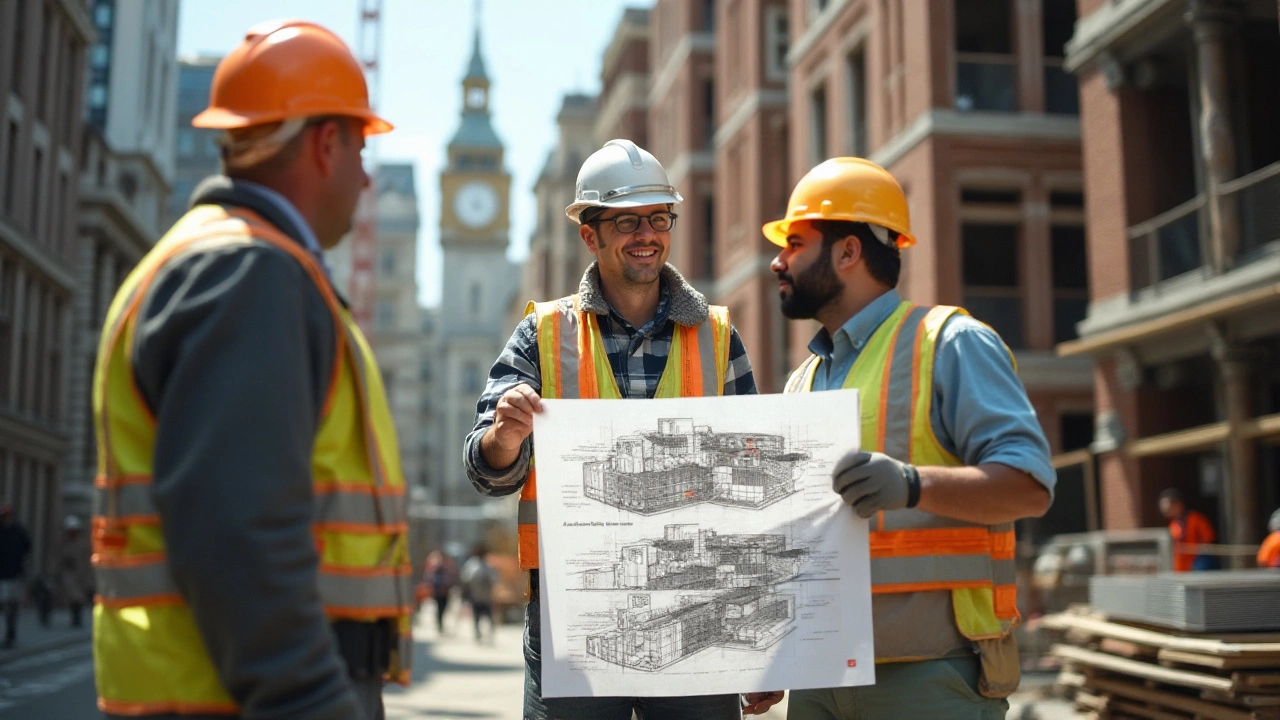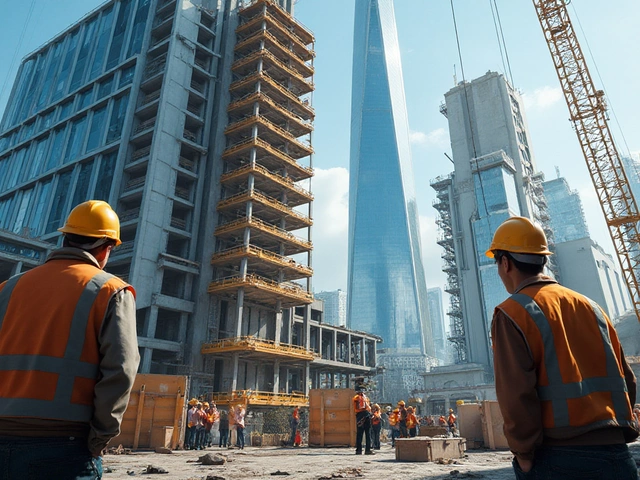Fire safety isn't just about having an emergency plan in place. It starts with the very fabric of the buildings we spend so much time in. For those involved in commercial construction, selecting the right materials can be the difference between minor damage and a catastrophic disaster.
In this changing landscape, more resilient building designs are becoming a necessity. But what makes a construction truly fire-resistant? While traditional materials have long set the benchmark, modern innovations in fireproofing have introduced fresh solutions that were once unimaginable.
Join us as we explore the best options available today, each offering its unique strength in building safer, longer-lasting commercial structures.
- Understanding Fire Resistance in Construction
- Popular Fire-Resistant Materials
- Innovative Techniques and Technologies
- Regulations and Standards
- Choosing the Right Strategy for Your Project
Understanding Fire Resistance in Construction
Fires can be devastating, not only because of the loss of property but also due to the potential threat to human life. It's crucial that commercial construction addresses these risks with effective fire-resistant strategies. Understanding the principles of fire resistance starts with knowing the science behind why certain materials react differently when exposed to fire. The fire resistance of a material is typically measured by how long it can withstand exposure to flame and heat while maintaining its structural integrity.
Traditionally, materials like concrete and steel have been admired for their robustness against fire. Concrete, for example, naturally resists fire due to its non-combustible nature and ability to retain structural strength even at high temperatures. Steel, while incredibly strong, can lose its integrity under intense heat unless treated with fire-resistant coatings. This is why the selection of fire-resistant materials in commercial construction is critical—it’s about creating barriers that slow down fire and provide more time for evacuation and emergency response teams to act.
The Role of Building Codes and Standards
Building codes and standards play an essential role in ensuring that structures adhere to minimum fire safety requirements. These regulations often dictate the types of materials that can be used and the methods of construction that best mitigate fire risks. In places like the United Kingdom, the Building Act mandates certain protocols for fire safety, emphasizing the importance of structural strength and containment during a fire event. As noted by the National Institute of Standards and Technology, the design strategies should include both passive systems—like fire-resistant walls and floors—and active systems such as sprinkler installations.
"Passive fire protection, involving containment and compartmentalization, forms the backbone of fire safety in commercial structures," highlights John Smith, an expert in fire safety engineering.
Materials engineered for fire resistance contribute to passive protection by serving as barriers that compartmentalize fires. This methodically limits the spread of fire, helping to safeguard lives and contain damage. Understanding and leveraging these guidelines is imperative not only for compliance but also for the development of safer and more efficient architectural designs. Quality construction built on a comprehensive understanding of fire resistance can transform how society approaches safety, potentially leading to innovations in sustainable and resilient building practices that are necessary in a world where urban settings are densely populated.
Popular Fire-Resistant Materials
When discussing fire-resistant construction, the materials used are pivotal in determining how well a building can withstand the harshest conditions. Concrete is often at the forefront of conversations about fire-resistant materials. Known for its durability and resistance, concrete can endure the high temperatures faced during a fire for extended periods. This is largely because it doesn't burn and significantly slows down the passage of heat through its dense structure. Steel, when treated properly with fire-resistant coatings, also serves as an invaluable component in commercial buildings. Although steel has a melting point that allows it eventually to yield under extreme heat, protective layers ensure it maintains structural integrity longer than untreated steel.
Brick is another traditional material, well-celebrated for vitally contributing to fire-resistant properties. It possesses inherent fire resistance, having been created in furnaces far hotter than most fires. The absence of toxic gases emitted from bricks during a fire further enhances its desirability. Of the newer materials gaining traction, gypsum board, or drywall, offers substantial fire resistance when used as part of a multi-layer system. Its unique composition of crystallized water means it not only halts the spread of flames but also helps control the temperature of surfaces. Smart utilization of these properties can dramatically increase the safety quotient within commercial spaces.
"Material selection plays a crucial role in fire safety strategies for buildings. New technologies continue to enhance the resilience of traditional options, providing greater protection and peace of mind." – Institute for Building Material Research
There has also been a rise in engineered materials, designed specifically for high fire resistance. Materials such as intumescent paint, which expands when exposed to heat to form a protective barrier, are now being utilized more frequently. These coatings assist in shielding underlying materials, making them less susceptible to heat and flames. Fire-retardant plywood is another modern innovation, treated with chemical solutions to resist ignition. While such engineered materials require adequate installation and regulatory compliance, their contribution to increasing fire safety standards cannot be overstated.
The Role of Regulations
Local building codes often dictate the specific fire resistance ratings required for buildings, compelling designers to choose appropriately certified materials. It's not merely about achieving compliance; it's about safeguarding not just material assets but, more importantly, human lives. Looking ahead, the integration of multiple fire-resistant materials, combined with advanced design techniques, offers promising prospects for those prioritizing safety in their commercial spaces.
| Material | Fire Resistance Duration |
|---|---|
| Concrete | Up to 4 hours |
| Brick | Around 2 hours |
| Gypsum Board | Approximately 1-2 hours |
| Fire-retardant Plywood | About 30-90 minutes |
The wide arsenal of building materials with inherent resistance to fire provides a robust foundation for modern commercial architecture. Selecting the right materials means acknowledging not just the cost implications but balancing these against the potential for real-world disasters. As both technology and materials science advance, new options inevitably expand the possibilities, propelling building safety into bold new territories.

Innovative Techniques and Technologies
In recent years, the field of commercial construction has witnessed a surge in innovative techniques aimed at enhancing fire resistance. These advancements not only offer improved safety but also bring new possibilities and efficiencies to the construction industry. One such innovation is the development of intumescent coatings, which expand when exposed to heat, creating a protective char layer that insulates structural elements from flames. This technology is particularly effective for steel structures, providing critical protection without compromising on load-bearing capacity.
Another exciting development is the use of aerogels in fire-resistant construction. Aerogels, known for their exceptional thermal insulation properties, are now being incorporated into building panels and window panes. Their application in buildings offers a lightweight yet highly effective solution, drastically reducing the threat of fire spreading through heat conduction. Companies have also been exploring the use of smart building systems, where integrated sensors monitor temperatures and detect early signs of fire, allowing for swift, automated responses such as activating sprinklers or alerting emergency services.
The concept of 'fire-safe wood' has also gained traction. Treated with specialized chemicals, this modified wood offers resistance comparable to more traditional, non-combustible materials, while still providing the aesthetic and structural benefits that many designers seek. In regions like Europe, where timber construction is sought after for its sustainability and environmental benefits, fire-safe wood represents a significant step forward. These advancements in materials and techniques not only enhance safety but often lead to cost savings in construction and maintenance as well.
"The focus on fire-resilient materials and smart technologies reflects a dynamic shift in commercial construction strategies," notes Dr. Emily Lewis, a leading expert in architectural engineering. "These innovations are not just about compliance with standards; they are about creating environments that inherently resist and respond to fire hazards."
The strategic implementation of these fire-resistant technologies is just one piece of the puzzle. Collaborative efforts between architects, engineers, and material scientists are crucial to pushing the boundaries of what's possible. One interesting approach involves using nanotechnology to enhance the properties of conventional construction materials, improving their fire resistance without affecting their structural integrity. This area, though still under exploration, holds significant promise for the future of building safety.
Through the integration of such cutting-edge solutions, the commercial construction landscape is becoming more adept at preventing and mitigating fire accidents. These techniques ensure that buildings are not only fortresses of safety but also contribute to the longevity and resilience of the infrastructure. As advancements continue, the line between technological innovation and practical application in construction becomes ever more seamless, promising a safer world for all.
Regulations and Standards
In the world of fire-resistant construction, adhering to the right regulations and standards is not just a matter of compliance, but a commitment to creating safer spaces. Regulations surrounding fire resistance in buildings stem from a dire need to protect lives, property, and investments. These rules are shaped by historical lessons and ongoing research into building safety and risk mitigation.
Regulations vary across the globe, reflecting different climates, urban densities, and historical building practices. In the United Kingdom, for instance, the Building Regulations Approved Document B outlines the fire safety requirements for buildings. It specifies everything from the types of permitted materials to the design of escape routes. These guidelines offer a roadmap for architects and builders, ensuring fire safety considerations are woven into the architectural process from the ground up.
One regulation highlights the need for non-combustible materials in the external walls of buildings over a certain height. Such requirements underscore the importance of strategic material selection in commercial construction. High-rise buildings, crowded spaces, and urban environments demand a meticulous approach to fire safety. This means that understanding regulations isn't just about adhering to laws—it's about implementing them in ways that protect users effectively.
We can consider the advancements made in Europe when it comes to the classification of fire-resistant materials. The Euroclass system categorizes construction materials by their reaction to fire, providing a standard for evaluating fire performance. Categories specified by this system, from A1 to F, help in assessing the combustibility and smoke production of materials. Such classifications offer a clear framework for decision-making, ensuring informed choices when selecting materials for a building's design.
Standards and Testing
Testing these materials is as crucial as understanding their classifications. The rigor in testing reveals how materials perform under realistic fire conditions. British and European standards, like BS 476 and EN 13501, detail methods for fire testing, making them principal references in the construction industry. These tests include examining how materials behave under heat, flame, and their tendency to emit smoke. The results of these tests often determine whether a material fits the specific safety requirements for a building project.
Adapting to evolving standards requires keeping an ear to the ground for new developments in fire safety science.
"Staying updated with regulatory changes ensures that constructions not only meet basic compliance but are optimized for the best safety practices. This proactive approach is vital," noted a spokesperson from the UK Fire Protection Association.Monitoring changes to regulations requires collaboration between various stakeholders, including architects, engineers, and safety officers. Successful projects often thrive on this multi-disciplinary input, with each professional bringing crucial insights to enhance a building’s safety profile.
Future Trends in Regulations
Looking ahead, regulatory landscapes are expected to evolve as technologies and understandings of fire dynamics advance. Innovations such as smart materials, which adapt their properties when exposed to fire, could well redefine building codes. Meanwhile, governments may continue to push for stricter standards, emphasizing the role of technology in ensuring compliance. By prioritizing these evolving standards, construction can meet modern demands while anticipating potential risks that lie ahead.
The integration of these standards and regulations into every phase of the construction process represents a promise—a promise to safeguard our communities and to build with integrity. As cities grow and building technology progresses, maintaining an informed approach to fire-resistant building materials becomes a cornerstone of successful and secure architectural projects.

Choosing the Right Strategy for Your Project
When planning any commercial construction, selecting a fire-resistant strategy tailored to your specific project can seem daunting. The key lies in understanding the particular risks that your building might face and matching those with suitable materials and designs. Consider the nature of your business, the value of the contents within, and the potential threats from nearby structures. A balanced approach integrates fire-resistant construction with other safety measures like sprinkler systems and alarms, forming a comprehensive defense mechanism. The aim is not just to prevent fires but to minimize damage if they occur, hence protecting both people and property.
To commence, start by evaluating the traditional options and their roles in reducing fire risk. Concrete, for example, is known for its ability to withstand high temperatures for extended periods. Its thick walls act as a barrier, slowing fire spread from room to room. However, while concrete is durable, it can be complemented with other materials like gypsum or fire-rated plasterboards to enhance its protective qualities. Similarly, bricks are favored due to their natural resistance to fire, but weighing their structural benefits against costs can be essential.
"The fact is, not every material fits every project," said Harriet Jones, a noted fire safety expert. "It's about finding what strikes the best balance between safety, aesthetics, and cost-effectiveness."Embracing innovative alternatives should be part of your strategy. Steel, enriched with intumescent coatings, expands when exposed to heat, forming a protective layer that insulates against flames. While historically steel might lose strength in high-temperature conditions, modern treatments have significantly increased its resilience.
Another notable advancement involves fire-retardant treated wood. Although wood is inherently flammable, treating it with chemicals that resist ignition can offer a sustainable option without compromising aesthetic values. This opens doors to eco-friendlier commercial construction without missing out on fire safety. Alongside these materials, architects and engineers often tap into cutting-edge technologies. Glass windows, once thought to be weak links in fire containment, now come rated for fire resistance. These advanced systems combine layers that can hold heat longer, providing critical escape time. Be sure to include these alongside more traditional methods, making provisions for flexible design modifications and pre-approved exit strategies.
Understanding regulatory standards is another cornerstone of formulating a robust strategy. Navigating these labyrinthine codes might feel overwhelming, but they ensure your project aligns with the latest fire-resistant construction practices. An informed team equipped with the right set of skills will blaze a trail, ensuring your building is a beacon of safety in the wider spectrum of commercial construction. When in doubt, consultants and fire safety engineers can provide personalized insight, developing a tailored plan—one that amalgamates design innovation, cost, and statutory compliance. Their role is part educator, part guide, ensuring the journey from blueprint to structure is both seamless and secure. Set your priorities right by thinking long-term durability over short-term gains, then implement a layered safety approach.





